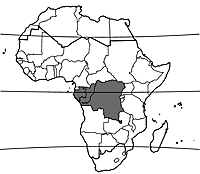Cynometra lujae (PROTA)
Introduction |
Cynometra lujae De Wild.
- Protologue: Ann. Mus. Congo Belge, Bot., sér. 5, 1: 250 (1906).
- Family: Caesalpiniaceae (Leguminosae - Caesalpinioideae)
Origin and geographic distribution
Cynometra lujae occurs in southern Gabon, southern Congo, south-western DR Congo and Cabinda (Angola).
Uses
The wood is suitable for heavy and hydraulic construction, bridges, joinery, doors, window frames, vehicle bodies, furniture, railway sleepers, sporting goods, tool handles and precision equipment.
The bark is used in traditional medicine in Congo to treat toothache, cough and rheumatism.
Properties
The heartwood is reddish brown with a purplish tinge and with yellowish brown markings, distinctly demarcated from the up to 8 cm wide, brownish yellow sapwood. The grain is usually straight, sometimes interlocked, texture fine.
The wood is heavy, with a density of (760–)855–995 kg/m³ at 12% moisture content. The rates of shrinkage during drying are moderately high.
At 12% moisture content, the modulus of rupture is 174–205 N/mm², modulus of elasticity 15,000 N/mm², compression parallel to grain 55–90 N/mm², cleavage 21.5 N/mm and Chalais-Meudon side hardness 13.5.
The wood saws slowly. Planing may occasionally result in rough surfaces due to the presence of interlocked grain. Pre-boring is needed for nailing and screwing, but the wood holds nails and screws well. It is durable, being resistant to fungal and termite attacks, but liable to marine borer attack.
Several imidazole alkaloids have been isolated from the bark and leaves.
Description
- Evergreen small to medium-sized tree up to 20(–30) m tall; bole branchless for up to 12(–20) m, up to 45(–65) cm in diameter; bark surface smooth, greenish brown, inner bark brown; twigs short-hairy, with whitish lenticels.
- Leaves arranged spirally, paripinnately compound with 5–11 pairs of leaflets; stipules linear, 1–1.5 cm long, caducous; petiole and rachis together 3–15 cm long, grooved above and slightly winged, short-hairy; leaflets opposite, sessile, oblong to elliptical, 1–6 cm × 0.5–2.5 cm, usually rounded at apex, slightly hairy below.
- Inflorescence an axillary or terminal panicle up to 12 cm long, short-hairy; bracts small.
- Flowers bisexual, nearly regular, whitish or slightly pinkish; pedicel 0.5–1.5 cm long, short-hairy, jointed near apex and persistent after shedding of flowers; sepals 4, ovate to oblong, 3.5–4 mm long, reflexed; petals 5, free, oblong, 4–4.5 mm long; stamens 10, free, 6–8 mm long, slightly unequal; ovary superior, ellipsoid, c. 2 mm long, with short stipe, hairy, 1-celled, style 3–4 mm long.
- Fruit a slightly obliquely oblong-obovate, flat pod 6.5–7 cm × 3–3.5 cm, with short stipe, short-pointed at apex, smooth and brown, dehiscent with 2 woody, twisting valves, 1–2-seeded.
- Seeds rounded, dark brown.
- Seedling with epigeal germination; hypocotyl 2.5–3.5 cm long, epicotyl 6.5–8 cm long; cotyledons oblong, thick and fleshy, wrinkled; first 2 leaves alternate, with 8–10 leaflets.
Other botanical information
Cynometra lujae closely resembles Cynometra hankei Harms, which differs in its leaves generally having more and smaller leaflets; moreover, the leaflets of Cynometra hankei are usually notched at apex and glabrous.
Cynometra comprises about 90 species and occurs in the tropical regions of the world. Approximately 25 species can be found in mainland tropical Africa and about 10 in Madagascar. Tropical Asia and tropical America have about 25 species each.
Ecology
Cynometra lujae occurs in evergreen lowland forest.
Management
A bole harvested in southern DR Congo of 19.5 m long and 65 cm in diameter yielded 4 m³ of wood.
Genetic resources
Although Cynometra lujae seems to have a rather limited area of distribution, there are no indications that it is threatened by genetic erosion.
Prospects
The high natural durability and high resistance to abrasion of the wood offer possibilities for timber production for special purposes. However, the often small size of the bole makes Cynometra lujae less interesting for commercialization.
Major references
- Aubréville, A., 1968. Légumineuses - Caesalpinioidées (Leguminosae - Caesalpinioideae). Flore du Gabon. Volume 15. Muséum National d’Histoire Naturelle, Paris, France. 362 pp.
- Fouarge, J. & Gérard, G., 1964. Bois du Mayumbe. Institut National pour l’Etude Agronomique du Congo (INEAC), Brussels, Belgium. 579 pp.
- Tchissambou, L., Benechie, M. & Khuong-Huu, F., 1982. Alcaloides imidazoliques – VI. Alcaloides du Cynometra lujae; isolement, structures, synthese. Tetrahedron 38(17): 2687–2695.
- Wilczek, R., Léonard, J., Hauman, L., Hoyle, A.C., Steyaert, R., Gilbert, G. & Boutique, R., 1952. Caesalpiniaceae. In: Robyns, W., Staner, P., Demaret, F., Germain, R., Gilbert, G., Hauman, L., Homès, M., Jurion, F., Lebrun, J., Vanden Abeele, M. & Boutique, R. (Editors). Flore du Congo belge et du Ruanda-Urundi. Spermatophytes. Volume 3. Institut National pour l’Étude Agronomique du Congo belge, Brussels, Belgium. pp. 234–554.
Other references
- Simpson, W.T., 1996. Method to estimate dry-kiln schedules and specific groupings: Tropical and temperate hardwoods. Research paper FPL-RP-548, Forest Products Laboratory, Forest Service, Department of Agriculture, Madison WI, United States. 57 pp.
- Tailfer, Y., 1989. La forêt dense d’Afrique centrale. Identification pratique des principaux arbres. Tome 2. CTA, Wageningen, Pays Bas. pp. 465–1271.
Author(s)
- R.H.M.J. Lemmens, PROTA Network Office Europe, Wageningen University, P.O. Box 341, 6700 AH Wageningen, Netherlands
Correct citation of this article
Lemmens, R.H.M.J., 2011. Cynometra lujae De Wild. [Internet] Record from PROTA4U. Lemmens, R.H.M.J., Louppe, D. & Oteng-Amoako, A.A. (Editors). PROTA (Plant Resources of Tropical Africa / Ressources végétales de l’Afrique tropicale), Wageningen, Netherlands.
Accessed 21 December 2024.
- See the Prota4U database.

